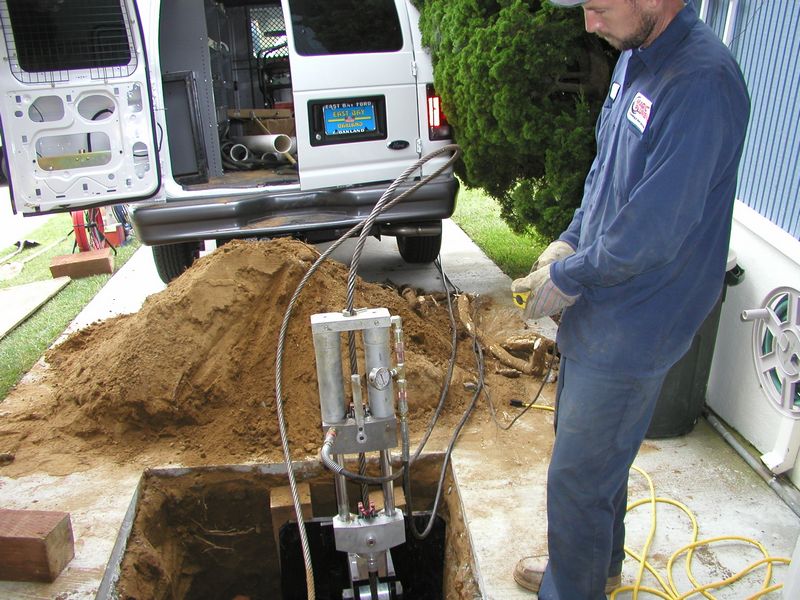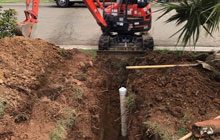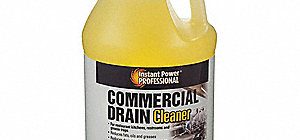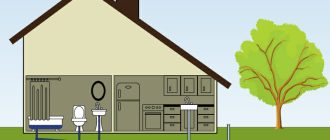
Learn About Trenchless Sewer Lines: Installation and Benefits
Trenchless sewer line replacement is a modern and innovative solution to fix sewer line issues without the need for extensive excavation. This method is revolutionizing the way sewer lines are repaired, saving time, money, and minimizing disruption to properties and the environment.
Trenchless sewer line replacement is a technique that involves using advanced technology and specialized equipment to repair or replace damaged or aging sewer lines. Unlike traditional methods that require digging up the entire length of the sewer line, trenchless technology allows for repairs to be made with minimal excavation.
With trenchless sewer line replacement, a small access point is created at the beginning and end of the damaged area. Through these access points, a new sewer line can be installed, essentially creating a seamless, durable pipe within the existing line. This method eliminates the need for large trenches and disruption to landscaping, driveways, and other structures.
Not only is trenchless sewer line replacement more efficient and cost-effective, but it also offers several other benefits. It reduces the risk of damage to underground utilities, minimizes the potential for environmental contamination, and decreases the overall project timeline.
Whether you have a residential or commercial property, understanding the benefits of trenchless sewer line replacement can help you make an informed decision when it comes to maintaining and repairing your sewer system. In this article, we will delve into the details of this innovative technology, explore the different methods used, and discuss the advantages that trenchless sewer line replacement offers.
The Basics of Trenchless Sewer Lines
Trenchless sewer line replacement is a modern and innovative method of repairing or replacing damaged sewer pipes without the need for extensive excavation. Traditionally, sewer line repairs required digging trenches to access and repair or replace the damaged pipes. However, with trenchless sewer line replacement, the process is much more efficient and less invasive.
In trenchless sewer line replacement, there are two main methods used:
1. Pipe lining: This method involves inserting a flexible resin-coated tube into the damaged sewer pipe. The tube is then inflated and left to harden, creating a new pipe within the existing damaged pipe. This eliminates the need for excavation and significantly reduces the disruption to the surrounding area.
2. Pipe bursting: This method involves using a specialized tool to break apart the damaged sewer pipe while simultaneously pulling a new pipe into place. The old pipe fragments are displaced into the surrounding soil, creating space for the new pipe. This method is particularly effective for replacing severely damaged or collapsed pipes.
The benefits of trenchless sewer line replacement include:
- Less disruption: Because trenchless methods require minimal excavation, there is less disruption to the surrounding landscape and property. This means less damage to driveways, sidewalks, and landscaping.
- Faster completion: Trenchless methods can often be completed in a shorter time frame compared to traditional methods. This reduces inconvenience and downtime for homeowners.
- Cost-effective: While trenchless sewer line replacement may have a higher upfront cost, the long-term savings from reduced repairs and maintenance make it a cost-effective choice.
- Durable and long-lasting: The materials used in trenchless methods are highly resistant to corrosion and environmental factors, resulting in durable and long-lasting sewer lines.
Overall, trenchless sewer line replacement offers a more efficient, less invasive, and cost-effective solution for repairing or replacing damaged sewer pipes.
Understanding Trenchless Sewer Technology
Trenchless sewer line replacement is a modern technology that offers a more efficient and cost-effective solution to traditional sewer line repair methods. This innovative method eliminates the need for extensive excavation and trenching, making it a preferred choice for homeowners and businesses alike.
With trenchless sewer technology, a new sewer line can be installed without the need for digging up the entire yard or disrupting the surrounding landscape. Instead, specialized equipment is used to access the sewer line through small entry points. These entry points are strategically placed at various intervals along the existing pipe.
One method used in trenchless sewer line replacement is pipe bursting. This involves inserting a new pipe into the existing damaged pipe. The new pipe is then expanded and breaks apart the old pipe, effectively replacing it. Another method is pipe lining, where a flexible and durable liner is inserted into the existing pipe. The liner is then cured in place, creating a new seamless pipe within the old pipe.
There are several advantages to using trenchless sewer technology. Since there is minimal digging involved, the disruption to the property is significantly reduced. This means that landscaping, driveways, and other structures can remain intact. Additionally, the process is faster and more efficient, minimizing the inconvenience caused by sewer line repairs.
Trenchless sewer line replacement is also cost-effective in the long run. While the initial costs may be higher than traditional methods, the durability and lifespan of the new pipes make it a worthwhile investment. Trenchless repairs can last for decades, reducing the need for frequent repairs and replacements.
In conclusion, trenchless sewer technology offers a modern and effective solution for sewer line replacement. With its minimal disruption, efficiency, and long-lasting results, it is a method that is gaining popularity in the plumbing industry. If you are facing sewer line issues, consider trenchless sewer line replacement as a viable solution.
Benefits of Trenchless Sewer Lines
Trenchless sewer line replacement offers several advantages over traditional excavation methods. Here are some of the key benefits:
| 1. Cost-effective | Trenchless sewer line replacement can save you money in the long run. Since there is no need for extensive excavation, this method requires less labor and materials, resulting in lower overall costs. |
| 2. Minimal disruption | Unlike traditional sewer line replacement, trenchless methods minimize disruption to your property. With no need to dig up your yard or driveway, you can avoid the headache of restoring your landscaping or repairing any damage caused by excavation. |
| 3. Faster installation | Trenchless sewer line replacement typically takes less time to complete compared to traditional methods. With no digging involved, the process can be completed quickly, allowing you to get back to your daily routine sooner. |
| 4. Durable and long-lasting | Trenchless sewer lines are designed to be durable and long-lasting. Made from materials such as high-density polyethylene (HDPE) or cured-in-place pipe (CIPP), these pipes are resistant to corrosion and root intrusion, ensuring a reliable and efficient sewer system for years to come. |
| 5. Versatility | Trenchless sewer line replacement can be used in a variety of situations and environments. Whether your sewer line is located under a busy road, underneath a building, or in a hard-to-reach area, trenchless methods can provide a solution without the need for extensive excavation. |
| 6. Environmentally friendly | Trenchless sewer line replacement is a greener alternative to traditional excavation methods. By minimizing the amount of digging required, this method reduces the impact on the environment, including the disruption of natural habitats and the generation of excess waste. |
How Trenchless Sewer Lines Are Installed
Trenchless plumbing is a method used to install sewer lines without the need for digging trenches. This innovative technique offers several advantages over traditional excavation methods.
Firstly, trenchless sewer line installation is less invasive and disruptive compared to traditional methods. Instead of tearing up your yard, this technique allows the installation of sewer lines through small access points. This means minimal damage to your landscape, less noise, and reduced inconvenience for you and your neighbors.
There are two primary methods of trenchless sewer line installation: pipe bursting and pipe lining.
- Pipe bursting: In pipe bursting, a new pipe is pulled through the existing damaged pipe. The new pipe bursts the old pipe into fragments, which are then pushed into the surrounding soil. This method is suitable when the existing pipe is severely damaged or collapsed.
- Pipe lining: Pipe lining, also known as cured-in-place pipe (CIPP) lining, involves inserting a flexible liner coated with resin into the existing pipe. The liner is then inflated and left to cure, creating a new pipe within the old one. This method is effective for repairing pipes with minor damage, cracks, or corrosion.
Both methods offer efficient and durable solutions for sewer line installation and repair. They eliminate the need for extensive excavation, saving time and money. Additionally, trenchless installation reduces the risk of future pipe damage, as the new pipes are resistant to root intrusion and corrosion.
Overall, trenchless sewer line installation is a cost-effective, efficient, and environmentally friendly alternative to traditional excavation methods. It minimizes the disruption to your property and ensures the longevity of your sewer system. If you’re in need of sewer line installation or repair, consider the advantages of trenchless plumbing.
Types of Trenchless Sewer Repair Methods
When it comes to repairing a trenchless sewer line, there are several methods that can be used. These methods are designed to minimize the need for digging trenches, which can be costly and disruptive. Here are some common types of trenchless sewer repair methods:
- Pipe lining: This method involves inserting a flexible liner into the damaged pipe and then inflating it. The liner is coated with a resin that hardens, creating a new pipe within the existing one.
- Pipe bursting: In this method, a new pipe is pulled through the old one, causing the old pipe to break apart. The new pipe takes its place and is made from a material that is resistant to corrosion and root intrusion.
- Slip lining: Slip lining is similar to pipe lining, but instead of inflating a liner, a smaller pipe is inserted into the damaged one. The space between the two pipes is then filled with grout or another suitable material.
- Directional drilling: This method is used when a new sewer line needs to be installed. A small hole is drilled at the entry and exit points, and a drill bit is used to create a path for the new pipe. The new pipe is then pulled through the drilled hole.
- Cured-in-place pipe (CIPP): CIPP involves inserting a liner soaked in resin into the damaged pipe. Heat or steam is then used to cure the resin, creating a solid, jointless pipe within the existing one.
Each of these trenchless sewer repair methods has its own advantages and disadvantages. The choice of method will depend on factors such as the extent of the damage, the type of pipe, and the accessibility of the site. It is recommended to consult with a professional plumber to determine the best method for your specific situation.
When to Consider Trenchless Sewer Line Replacement
There are several situations where trenchless sewer line replacement may be the best option. Here are a few scenarios where you should consider this method:
|
1. Limited Access: If your sewer line is located under a building, driveway, or other inaccessible area, trenchless sewer line replacement can help minimize disruption and avoid the need for extensive excavation. |
|
2. Obstructions: If your sewer line is obstructed by tree roots or other debris, trenchless methods can clear the blockage and replace the damaged section without the need for digging up the entire line. |
|
3. Time Constraints: If you need a quick solution for a sewer line problem, trenchless sewer line replacement can often be completed more efficiently and in less time compared to traditional excavation methods. |
|
4. Cost Considerations: In some cases, trenchless sewer line replacement may be a more cost-effective option, especially if there are obstacles or difficult terrain that would increase the expenses associated with traditional digging and restoration. |
It’s important to consult with a professional plumbing company to assess your specific situation and determine if trenchless sewer line replacement is the best solution for your needs. They can provide a comprehensive evaluation and explain the benefits and limitations of this method.
Cost and Time Considerations for Trenchless Sewer Repair
When it comes to repairing sewer lines, trenchless plumbing is becoming an increasingly popular option for homeowners. This innovative method eliminates the need for digging up your yard, resulting in less disruption to your landscape and a faster repair process.
One of the major factors that homeowners consider when deciding on a sewer repair method is cost. Trenchless sewer repair may initially seem more expensive than traditional methods, but when you factor in the cost of restoring your landscaping and repairing any damage caused by digging up your yard, trenchless repair often proves to be the more cost-effective option in the long run.
Not only does trenchless sewer repair save you money on landscaping costs, but it also saves you time. Traditional sewer repair methods can take several days to complete, as crews have to dig trenches, make the repairs, and then fill in the trenches. With trenchless repair, the process is much quicker. In many cases, the repair can be completed in just one or two days, depending on the extent of the damage.
Another time-saving benefit of trenchless plumbing is the reduced disruption to your daily routine. Since there is no need to excavate your yard, you can continue with your normal activities without having to worry about noise, dust, and inconvenience associated with traditional sewer repair methods.
Overall, the cost and time savings associated with trenchless sewer repair make it a highly appealing option for homeowners. Not only does it eliminate the need for extensive yard restoration, but it also allows for a quicker repair process and less disruption to your daily life. If you are facing sewer line issues, it’s worth considering trenchless plumbing as a viable and efficient solution.
Common Issues and Solutions for Trenchless Sewer Lines
Trenchless sewer line replacement has become increasingly popular in recent years due to its numerous benefits. However, like any type of plumbing system, trenchless sewer lines can still experience issues that may require repair or replacement.
One common issue with trenchless sewer lines is the buildup of tree roots. Over time, tree roots can infiltrate and obstruct the pipes, causing blockages and decreased flow. To address this issue, a professional plumber can use a high-pressure water jet to clear the roots and restore proper water flow.
Another common issue is the formation of cracks or leaks in the sewer lines. These cracks can occur due to age, ground shifting, or external forces. Fortunately, trenchless technology offers a solution for repairing these cracks without the need for extensive excavation. A specialized lining is inserted into the damaged pipe, which then hardens and forms a new, durable pipe within the old one.
Corrosion is yet another common issue that can affect trenchless sewer lines. Over time, exposure to moisture and various chemicals can cause the pipes to corrode, leading to leaks and reduced functionality. Depending on the severity of the corrosion, the pipes may need to be repaired or replaced using trenchless methods.
One advantage of trenchless sewer line replacement is the ability to address multiple issues simultaneously. For example, if a pipe is severely damaged due to corrosion and also has tree roots blocking the flow, the plumber can repair both issues in one operation. This saves time and reduces the need for additional repairs in the future.
In conclusion, trenchless sewer lines offer a range of benefits, but they are not immune to common issues. With the help of professional plumbers and the use of trenchless technology, these issues can be efficiently addressed, ensuring the longevity and functionality of the sewer system.
Maintenance Tips for Trenchless Sewer Lines
Proper maintenance is essential to keep trenchless sewer lines in good condition and prevent costly repairs. Here are some maintenance tips to help you maintain your trenchless plumbing:
1. Regular Inspections: Schedule regular inspections of your trenchless sewer lines to identify any potential issues before they become major problems. A professional plumber can use specialized equipment to inspect the pipes and determine their condition.
2. Avoid Chemical Drain Cleaners: Chemical drain cleaners can corrode the pipes and cause damage to trenchless sewer lines. Instead of using harsh chemicals, opt for natural alternatives or contact a professional plumber to remove any clogs.
3. Use Biodegradable Products: When it comes to cleaning or flushing items down the drain, choose biodegradable products. This will help prevent any buildup or blockages within the sewer lines.
4. Prevent Tree Root Intrusion: Tree roots are a common cause of sewer line damage. To prevent tree root intrusion, avoid planting trees or large shrubs near trenchless sewer lines. If you already have trees nearby, consider installing root barriers to keep the roots from reaching the pipes.
5. Be Mindful of What Goes Down the Drain: To avoid clogs and potential damage to trenchless sewer lines, be mindful of what you flush down the drain. Avoid flushing items such as grease, oil, paper towels, feminine hygiene products, and other non-biodegradable materials.
Remember, proper maintenance is key to the longevity and efficiency of your trenchless sewer lines. If you encounter any issues or suspect a problem, don’t hesitate to contact a professional plumber for assistance.
Comparing Trenchless Sewer Repair to Traditional Methods
When it comes to repairing sewer lines, there are two main methods: trenchless plumbing and traditional excavation. Both methods have their advantages and disadvantages, so it’s important to understand the differences between them.
Trenchless Plumbing:
Trenchless plumbing, also known as trenchless sewer repair, is a modern and innovative approach to fixing sewer line problems. This method involves repairing or replacing damaged pipes without the need for extensive excavation. Instead, specialized equipment is used to access the pipe from existing access points or by creating small entry points.
One of the biggest benefits of trenchless plumbing is the minimal disruption it causes to your property. Since there is no need for digging large trenches, your yard, driveway, or landscaping can remain intact. This not only saves time and money but also reduces the hassle and inconvenience typically associated with traditional excavation methods.
Another advantage of trenchless plumbing is the speed at which the repairs can be completed. In most cases, the job can be finished in a matter of hours or a few days, depending on the extent of the problem. This is much faster compared to traditional methods, which can take weeks or even months to complete.
Traditional Excavation:
Traditional excavation, on the other hand, involves digging a trench to access and repair the damaged sewer line. This method has been used for many years and is still a popular choice in certain situations.
One of the main disadvantages of traditional excavation is the extensive damage it can cause to your property. The digging process can destroy landscaping, driveways, walkways, and other structures. This can result in additional costs for repairing or replacing these features.
Moreover, traditional excavation is often a time-consuming process. It involves several steps, including digging the trench, repairing the sewer line, backfilling the trench, and restoring the affected areas. This can prolong the repair timeframe and cause inconvenience for homeowners.
In conclusion, trenchless sewer repair offers numerous advantages over traditional excavation methods. It minimizes property damage, saves time and money, and provides a more convenient and efficient solution for fixing sewer line problems. However, it’s important to consult with a professional plumber to determine the best method for your specific situation.
Q&A:
What is a trenchless sewer line?
A trenchless sewer line is a method of replacing or repairing underground sewer pipes without the need for traditional excavation methods.
How does trenchless sewer line repair work?
Trenchless sewer line repair involves inserting a new pipe liner or pipe bursting the existing pipe to create a new pipe within the old one. This eliminates the need for digging up the entire pipe.
What are the benefits of using trenchless sewer lines?
Using trenchless sewer lines has several benefits, including reduced disruption to your property, lower cost, faster installation or repair times, and less environmental impact.
Can all sewer pipes be repaired using trenchless methods?
Not all sewer pipes can be repaired using trenchless methods. The suitability of trenchless sewer line repair depends on factors such as the condition and material of the existing pipe, accessibility, and local regulations.
Are trenchless sewer line repairs more expensive than traditional methods?
Trenchless sewer line repairs may initially appear more expensive than traditional methods, but they often offer cost savings in the long run due to reduced labor and restoration costs.





